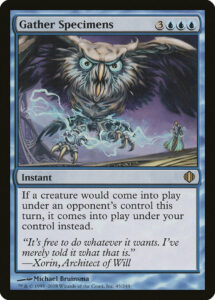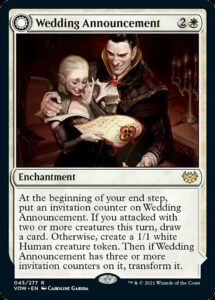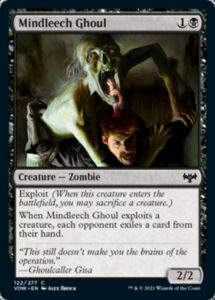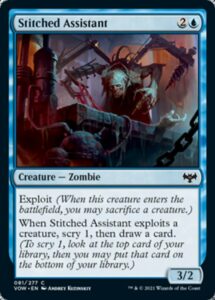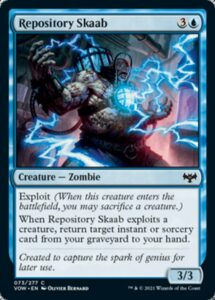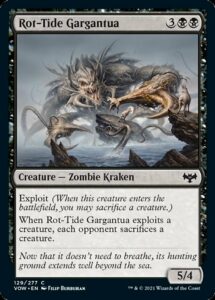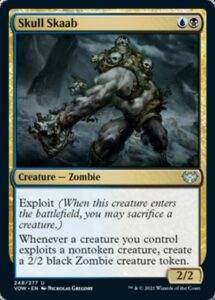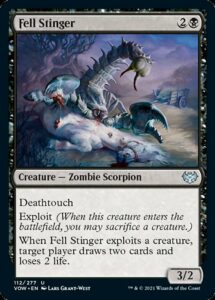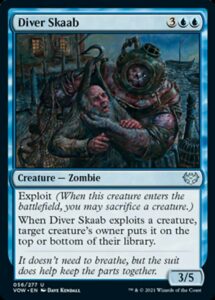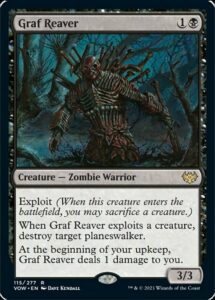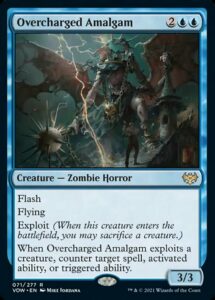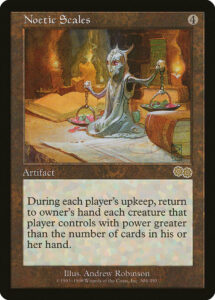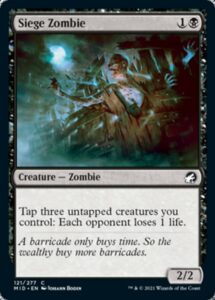Exploit has underperformed in Innistrad: Crimson Vow and we’re getting to the root of the matter. Last week, we created a schema for evaluating Exploit cards and reviewed every such card in Dragons of Tarkir. This week, we’ll apply that schema to Crimson Vow and conclude with what factors are keeping Exploit down.
The parameters
As a reminder, these are our parameters from last week. Feel free to give them a review or proceed directly to our card analysis.
Exploit Spell & Mana Value: Each Exploit creature effectively casts a spell when they Exploit. What is that spell? And more importantly, what is its mana value? This provides a reasonably good approximation of how much value you receive by Exploiting. In general, if you sacrifice a creature cheaper than the mana value, you’re getting a lot of bang for your buck.
Here, mana value isn’t always a whole number—effects like Counterspell and Night’s Whisper cost about 2.5 mana (they usually cost 3 and come with a minor advantage, or cost 2 and have downsides/restrictions). We’ll also fudge it a bit, since an instant speed Unsummon is far more powerful than a sorcery speed one, but we’ll still call it a 1 mana effect.
Spell Versatility: How easy is the spell to use? Disfigure generally has targets while Naturalize is much more situational. Lightning Bolt is the kind of spell you can always use, while not all decks are looking to cast Lava Spike.
Our next two dimensions pertain to the creature and how it relates to its Exploit ability.
Creature’s Rate: How good is the creature on its own? Stronger creatures and creatures with keywords don’t need to Exploit often in order to be impactful, while under-statted creatures basically always need to Exploit (and are more likely to sacrifice themselves to their own Exploit ability).
Mana Value relative to Exploit spell’s Mana Value: How much more expensive is the creature than the spell it casts by Exploiting? If the creature’s mana value is close to the Exploit spell it casts, it’s generally fine for it to Exploit itself. If there’s a big difference, you’ll rarely be advantaged by self-Exploiting and need the creature’s Rate to matter more.
Our final dimension is context, and it’s the same for most cards (with a few exceptions we’ll get into).
Context: This is all the ways the full set affects each dimension. It’s a measure of things like: How much sacrifice fodder is there? And what is the average mana value of a sacrificed creature? If most Exploit spells are mana value 2 and most Exploit fodder are mana value 1, then you have an easy time generating value via Exploiting. If the reverse is true and you’re sacrificing more expensive creatures to cast cheaper spells, then Exploiting is weaker.
Exploit in Crimson Vow
Context: As with Dragons of Tarkir, there’s a lot going on in Innistrad: Crimson Vow. It also has five allied color tribes, each with their own mechanic, plus a sixth mechanic in Cleave (which has a far less pronounced effect on the Limited format than Megamorph did in DTK). The format is also defined by plentiful bombs (Fate Reforged did that for DTK).
It’s worth noting that of the four other tribal mechanics, Training, Disturb, and werewolves all go on creatures, so it’s easy to have a high density of creatures for Exploit. Disturb even synergizes with Exploit by providing a suite of creatures that generate value upon death. Finally, Blood is a smoothing mechanic that helps you assemble the combo of creature + Exploit creature. All five tribal mechanics working with (or at least, not being antisynergistic with) Exploit sets it up for success.
There’s powerful Exploit fodder with Lantern Bearer and Doomed Dissenter. Then again, the other dedicated fodder, Persistent Specimen and Wretched Throng, have proved unimpressive. Persistent Specimen costing more than Reassembling Skeleton is a big cost, especially with how big green and black’s common creatures are. And Wretched Throng is worse than Squadron Hawk (the bodies are less useful and you slowly draw the cards) and arguably, Palace Familiar (a random card is usually better than a Goblin Piker).
All of that’s to say, Blue Black Exploit has a fair number of advantages. Its enablers range from strong to serviceable, but as long as the Exploit payoffs are reasonably strong, it’s totally fine to be sacrificing two drops for no value other than the Exploit trigger. And spoilers, that’s where the wheels fall off.
Mindleech Ghoul
Exploit Spell & Mana Value: None, 0.5 mana
This spell does not exist. Discarding cards is a lot like drawing extra cards: appending it to a card adds about two mana, but by itself, it’s worth a fraction of a mana and generally not worth a card.
Spell Versatility: Moderate/Low
It’s rare that your opponent has no cards in hand, so this will almost always hit. But there’s very little play to this effect, as you’re neither affecting the board nor generating resources—you’re instead forcing your opponent to discard their least relevant card.
Creature’s Rate: Moderate
A two mana 2/2 with minor upside is par for the course. It’s not exciting, but it’s not embarrassing.
Mana Value relative to Exploit Spell’s Mana Value: 1.5
One could point out this is identical to Vulturous Aven‘s (the best common Exploit creature in DTK) relative mana value. That’s true, but a 2.5 mana spell has much higher impact than a 0.5 mana spell.
Mindleech Ghoul‘s mediocre stats and low impact Exploit spell make it do nothing well except sacrifice creatures for little mana. That’s awesome if you’ve got a Biolume Egg (an incredibly powerful payoff), but not impressive even with a Doomed Dissenter.
Stitched Assistant
Exploit Spell & Mana Value: Opt, 1
Spell Versatility: High
Drawing cards is always good, and a little selection is always welcome.
Creature’s Rate: Moderate
A three mana 3/2 is pretty lackluster, but it both trades and pressures reasonably well.
Mana Value relative to Exploit Spell’s Mana Value: 2
Stitched Assistant is fairly similar to Mindleech Ghoul. It casts a better spell and has slightly better stats, but neither the spell nor the stats are impressive, and at a mana higher. But the critical issue is the low impact, low mana value spell. Sacrificing board presence for card quality (not even card advantage) is a risky and usually poor deal. Creatures nowadays are big enough that not having a play on two mana can be a serious stumble—here, you’re undoing your early play for a relatively minor and delayed advantage. And with the spell only costing one mana, you need your sacrifice fodder to generate value to justify the sacrifice.
Repository Skaab
Exploit Spell & Mana Value: Call to Mind/Flood of Recollection, 2.5
Spell Versatility: Moderate
This effect doesn’t always work, but usually is easy to build a deck around. And when it does work, drawing the best spell out of your graveyard both provides options and a high power level ceiling.
Creature’s Rate: Low/moderate
Hill Giants weren’t good in 2015 and they’re even worse now. You’re happy to play them with upside (Sarulf’s Packmate was the best common creature in Kaldheim), but purely on rate, this leaves something to be desired.
Mana Value relative to Exploit Spell’s Mana Value: 1.5
That’s a fine deal. It’s a decently enough expensive spell with a high enough effect that wasting a little bit of mana isn’t the end of the world.
Here, context is killer. Archaeomancers are good when you have strong cheap spells, so you can cast those spells and rebuy them on curve. However, the strong cheap spells in Crimson Vow are red (and red mostly lacks good Exploit fodder or interactions), so it’s hard to play this on curve. Moreover, Repository Skaab requires three separate components: a worthwhile spell in your graveyard, reasonable fodder on the battlefield, and your Repository Skaab at the right time. Exploit decks already have Exploit creatures filling their spell slots and need a high density of creatures to function, so Repository Skaab‘s Exploit reward is antisynergistic with Exploit’s requirement.
All told, too many things need to go right for you to. Pick up an Alchemist’s Retrieval and sacrifice both board presence and card advantage for tempo? If Gift of Fangs were a Disfigure variant, I think that alone would make UB a good deal stronger. Unfortunately, Repository Skaab, the common with the most powerful Exploit spell, has too much tension undermining an ability that’s too hard to use.
Rot-Tide Gargantua
Exploit Spell & Mana Value: Innocent Blood, 1
Technically, this is a 1.5 mana spell and closer to Cruel Edict than Innocent Blood by our schema, but come on—Rot-Tide Gargantua gives you the option of casting Innocent Blood when it enters the battlefield.
Spell Versatility: Low
Your opponent usually has creatures, but Diabolic Edicts force your opponent to lose their worst creature. This requires specific setup in order to function. It also loses a ton of value on turn five—you want to cast this on turns 2 or 3, when your opponent might actually be hampered by losing an early creature.
Creature’s Rate: Moderate/High
This is a pretty beefy creature at common, especially for black. Without keywords, it’s nothing to write home about and looks pretty sad next to Bloodcrazed Socialite; but this will have an impact on the battlefield and certainly isn’t embarrassing.
Mana Value relative to Exploit Spell’s Mana Value: 4
This is the worst deal offered by any Exploit creature. That doesn’t mean the card is bad, just most of its power is baked into being a five mana 5/4. It’s correct to not Exploit a fair amount of the time. When you do Exploit, you need a battlefield where your worst creature is worse than theirs (and ideally yours generates value upon dying).
Skull Skaab
Exploit Spell & Mana Value: Walking Corpse, 2
Generating a 2/2 token tends to cost 2 mana.
Spell Versatility: High
Generating board presence is basically always good.
Creature’s Rate: Moderate
Mana Value relative to Exploit Spell’s Mana Value: 0
As with Sidisi’s Faithful, this is the best deal you can possibly get with an Exploit creature. Of course, here you’re getting a slight downgrade if you Exploit it to itself rather than a completely different effect.
Skull Skaab is a cool design. It’s the only card that innovates on Exploit and is exactly what Exploit needs—it’s cheap and it helps the deck accumulate value every time it Exploits. The problem is that all of the common Exploit effects are weak, where the output you get from Exploiting tends to be worse than the input you sacrificed.
Fell Stinger
Exploit Spell & Mana Value: Painful Lesson, 2.5
This is essentially the same effect as Vulturous Aven, except with the ability to target your opponent for lethal.
Spell Versatility: High
Card advantage is awesome, even at the cost of tempo and board presence.
Creature’s Rate: High
Fell Stinger is awesome, able to apply pressure and trade with anything (that doesn’t have Flying or First Strike).
Mana Value relative to Exploit Spell’s Mana Value: 0.5
Fell Stinger is different from every other Exploit creature in Crimson Vow in that it gives you a great deal as a creature or Exploited to itself. When you Exploit something else for value, you generate enough advantage to swing a game while gaining a Deathtouch creature that does a great job of keeping you alive.
Diver Skaab
Exploit Spell & Mana Value: Time Ebb, 3
At instant speed, this costs 4 mana (Revenge of the Drowned & Griptide). This is slightly weaker by virtue of the opponent having a choice, but it’s still a three mana spell.
Spell Versatility: High
This impacts the board dramatically, either by delaying or effectively exiling your opponent’s best creature.
Creature’s Rate: Low/Moderate
Thraben Purebloods is a pretty lackluster creature on its own.
Mana Value relative to Exploit Spell’s Mana Value: 2
This is a big enough difference that you’re not happy to Exploit Diver Skaab to itself, but it is at least worth a card.
Diver Skaab is the opposite of Rot-Tide Gargantua. You basically always need to Exploit and aren’t happy with the stats on their own, but its Exploit effect is both very strong and gets better later as the game goes on.
Graf Reaver
Exploit Spell & Mana Value: Price of Betrayal, 0.5
There is no spell that just destroys a Planeswalker. Nowadays, it’s a free addition to removal spells that adds no mana.
Spell Versatility: Low
In Limited, this will almost always have no target. It’s definitely intended for Constructed.
Creature’s Rate: High*
A two mana 3/3 is a powerful creature. The Juzam Djinn downside shouldn’t matter much, except UB Exploit isn’t good at applying pressure. In fact, Exploit actively works against attacking your opponent with creatures. That makes Graf Reaver a good deal weaker than it appears.
Mana Value relative to Exploit Spell’s Mana Value: 1.5
Graf Reaver is an even more extreme version of Rot-Tide Gargantua. It exists purely as an above-rate creature and will almost never Exploit in Limited. That’s fine, though its drawback is more punishing than it appears.
Overcharged Amalgam
Exploit Spell & Mana Value: Dismiss, 3
Spell Versatility: Moderate
As with Silumgar Sorcerer, reactive spells are harder to use than proactive ones. There’s a cost to not spending your mana on your turn.
Creature’s Rate: High
Phantom Monster is allowed to be a common with mild upside nowadays, but Flash is a huge bonus to a creature big enough to eat an attacker.
Mana Value relative to Exploit Spells’ Mana Value: 1
Overcharged Amalgam is a high rate creature that can convert a cheap creature into a more expensive Voidslime. It does everything well without being overpowered, making it a nicely balanced design.
What went wrong?
Every common Exploit creature struggles to generate sufficient value. Mindleech Ghoul, Stitched Assistant, and Rot-Tide Gargantua all provide effects too small to justify sacrificing board presence. Repository Skaab is too hard to use and suffers from blue and black’s cheap spells being tempo-focused.
The uncommon Exploit creatures are very strong, as is the excellent enabler, Biolume Egg. However, the entire mechanic functions as a weaker version of Blood. Exploit demands you cast Exploit creatures to trade creatures on the battlefield (which you already cast) for spell effects. It’s about sacrificing real resources for advantage. Blood is generated for free, allows you to upgrade cards in hand (which you didn’t cast), and can be combined with other cards to make it even better. It’s about sacrificing bonus resources for advantage. Blood is inherently stronger, and the fact that BR Blood is the most powerful color combination makes it harder to draft UB uncontested.
I don’t think it’d take too much to make Exploit substantially stronger. We already mentioned replacing Gift of Fangs with a spell version so Repository Skaab had a good, cheap spell to get back (plus, it’d make it harder for UB to fall behind on board against BR). One of the three common Exploit creatures could cast a spell that cost more than 1 mana (imagine if Chill of the Grave were an Exploit effect rather than a card in the set). Wretched Throng being an actual Squadron Hawk on death might be too much, but what if it were an Oculus instead?
All told, it’s probably for the best that blue-black isn’t an overperforming, easy-to-use archetype. It was dominant in Midnight Hunt and it’d be a shame if it did so in two consecutive sets, especially on the same world. Plus, it’s probably harder for Exploit to succeed today than in 2015. Common creatures are stronger now, so it’s much a bigger ask to sacrifice them today than it was back then.
Hopefully you’ve enjoyed this deep delve into Exploit. I really love taking cards apart to understand how mechanics and formats tick. There are so many little decisions that collectively can tip something into overdrive, obscurity, or balance. There are so many tweaks design could have made that would’ve radically shifted the entire set. There are so many choices they made that makes one wonder all the earlier iterations that ended up on the cutting room floor. I live for this stuff, and whether you do too, or just enjoy being along for the ride, I thank you for joining me on this journey.
Zachary Barash is a New York City-based game designer and the commissioner of Team Draft League. He designs for Kingdom Death: Monster, has a Game Design MFA from the NYU Game Center, and does freelance game design. When the stars align, he streams Magic (but the stars align way less often than he’d like).

